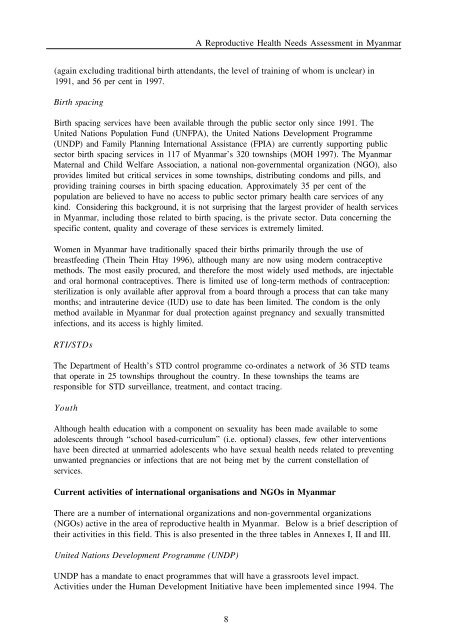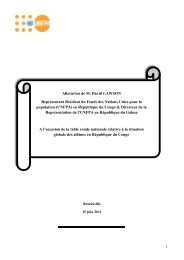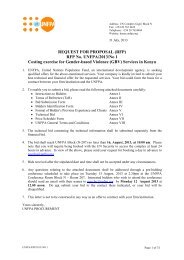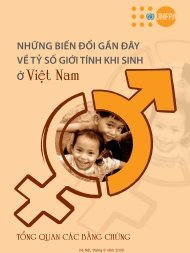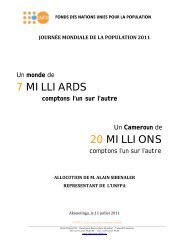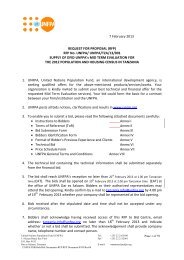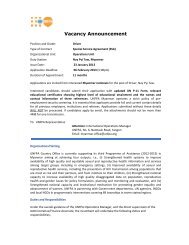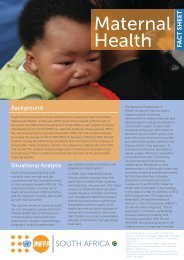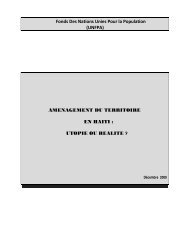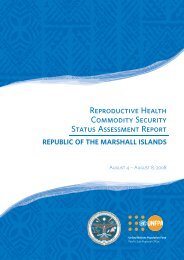A reproductive health needs assessment in Myanmar
A reproductive health needs assessment in Myanmar
A reproductive health needs assessment in Myanmar
Create successful ePaper yourself
Turn your PDF publications into a flip-book with our unique Google optimized e-Paper software.
A Reproductive Health Needs Assessment <strong>in</strong> <strong>Myanmar</strong><br />
(aga<strong>in</strong> exclud<strong>in</strong>g traditional birth attendants, the level of tra<strong>in</strong><strong>in</strong>g of whom is unclear) <strong>in</strong><br />
1991, and 56 per cent <strong>in</strong> 1997.<br />
Birth spac<strong>in</strong>g<br />
Birth spac<strong>in</strong>g services have been available through the public sector only s<strong>in</strong>ce 1991. The<br />
United Nations Population Fund (UNFPA), the United Nations Development Programme<br />
(UNDP) and Family Plann<strong>in</strong>g International Assistance (FPIA) are currently support<strong>in</strong>g public<br />
sector birth spac<strong>in</strong>g services <strong>in</strong> 117 of <strong>Myanmar</strong>’s 320 townships (MOH 1997). The <strong>Myanmar</strong><br />
Maternal and Child Welfare Association, a national non-governmental organization (NGO), also<br />
provides limited but critical services <strong>in</strong> some townships, distribut<strong>in</strong>g condoms and pills, and<br />
provid<strong>in</strong>g tra<strong>in</strong><strong>in</strong>g courses <strong>in</strong> birth spac<strong>in</strong>g education. Approximately 35 per cent of the<br />
population are believed to have no access to public sector primary <strong>health</strong> care services of any<br />
k<strong>in</strong>d. Consider<strong>in</strong>g this background, it is not surpris<strong>in</strong>g that the largest provider of <strong>health</strong> services<br />
<strong>in</strong> <strong>Myanmar</strong>, <strong>in</strong>clud<strong>in</strong>g those related to birth spac<strong>in</strong>g, is the private sector. Data concern<strong>in</strong>g the<br />
specific content, quality and coverage of these services is extremely limited.<br />
Women <strong>in</strong> <strong>Myanmar</strong> have traditionally spaced their births primarily through the use of<br />
breastfeed<strong>in</strong>g (The<strong>in</strong> The<strong>in</strong> Htay 1996), although many are now us<strong>in</strong>g modern contraceptive<br />
methods. The most easily procured, and therefore the most widely used methods, are <strong>in</strong>jectable<br />
and oral hormonal contraceptives. There is limited use of long-term methods of contraception:<br />
sterilization is only available after approval from a board through a process that can take many<br />
months; and <strong>in</strong>trauter<strong>in</strong>e device (IUD) use to date has been limited. The condom is the only<br />
method available <strong>in</strong> <strong>Myanmar</strong> for dual protection aga<strong>in</strong>st pregnancy and sexually transmitted<br />
<strong>in</strong>fections, and its access is highly limited.<br />
RTI/STDs<br />
The Department of Health’s STD control programme co-ord<strong>in</strong>ates a network of 36 STD teams<br />
that operate <strong>in</strong> 25 townships throughout the country. In these townships the teams are<br />
responsible for STD surveillance, treatment, and contact trac<strong>in</strong>g.<br />
Youth<br />
Although <strong>health</strong> education with a component on sexuality has been made available to some<br />
adolescents through “school based-curriculum” (i.e. optional) classes, few other <strong>in</strong>terventions<br />
have been directed at unmarried adolescents who have sexual <strong>health</strong> <strong>needs</strong> related to prevent<strong>in</strong>g<br />
unwanted pregnancies or <strong>in</strong>fections that are not be<strong>in</strong>g met by the current constellation of<br />
services.<br />
Current activities of <strong>in</strong>ternational organisations and NGOs <strong>in</strong> <strong>Myanmar</strong><br />
There are a number of <strong>in</strong>ternational organizations and non-governmental organizations<br />
(NGOs) active <strong>in</strong> the area of <strong>reproductive</strong> <strong>health</strong> <strong>in</strong> <strong>Myanmar</strong>. Below is a brief description of<br />
their activities <strong>in</strong> this field. This is also presented <strong>in</strong> the three tables <strong>in</strong> Annexes I, II and III.<br />
United Nations Development Programme (UNDP)<br />
UNDP has a mandate to enact programmes that will have a grassroots level impact.<br />
Activities under the Human Development Initiative have been implemented s<strong>in</strong>ce 1994. The<br />
8


